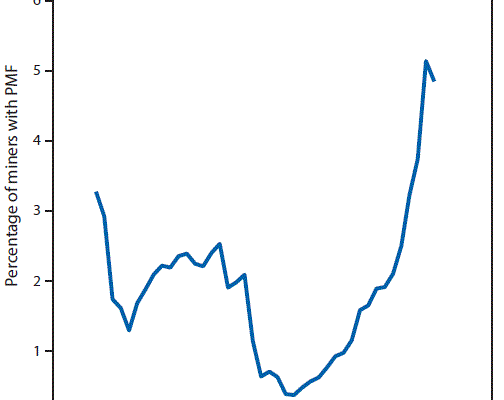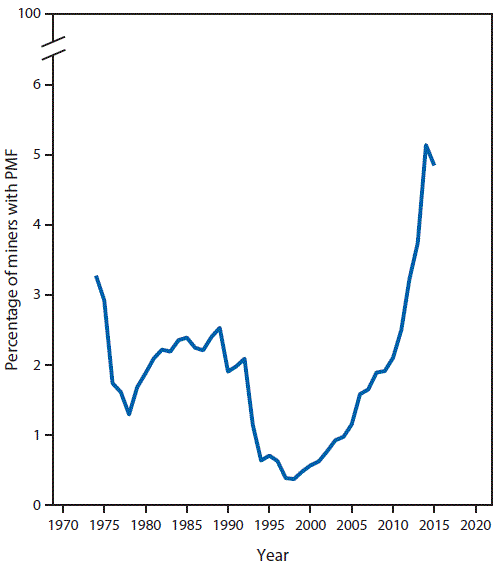NIOSH Article and NPR Story on Surging Rate of Complicated CWP

FIGURE 1. Prevalence of progressive massive fibrosis (PMF)* among underground-working coal miners with ≥25 years of underground mining tenure — Coal Workers’ Health Surveillance Program, Kentucky, Virginia, and West Virginia, 1974–2015
Two big pieces of news regarding black lung today.
First, the Center for Disease Control has published an article “Resurgence of Progressive Massive Fibrosis in Coal Miners — Eastern Kentucky, 2016.” The article has two major findings:
- Recent data from the NIOSH–administered Coal Workers’ Health Surveillance Program shows that the rate of black lung among coal miners with at least 25 years underground in West Virginia, Kentucky, and Virginia is higher than ever before. Based on current data, about 1 in 20 of these coal miners will now get severe black lung while the earliest data (from 1970) only showed that about 1 in 30 would. This is shown by the below chart:

FIGURE 1. Prevalence of progressive massive fibrosis (PMF)* among underground-working coal miners with ≥25 years of underground mining tenure — Coal Workers’ Health Surveillance Program, Kentucky, Virginia, and West Virginia, 1974–2015
2. A single radiology practice in Pike County, Kentucky has identified 60 distinct cases of progressive massive fibrosis over a 20-month period from January 1, 2015–August 17, 2016. By comparison, NIOSH’s Coal Workers’ Health Surveillance Program only identified 31 unique cases during the entire decade from 1990–1999. That is, a single radiologist pulling patients largely from four Kentucky counties has identified nearly twice as much complicated CWP as was identified nationwide during the 90s.
Second, National Public Radio’s (NPR) Howard Berkes is running a two-part radio piece “Advanced Black Lung Cases Surge In Appalachia” (available here.) NPR got data from black lung clinics across Appalachian and identified over 1,000 cases of PMF during the past decade—10 times what the official data recognizes. The NPR piece interviews Mackie Branham a 39-year-old coal miner from Pike County, KY with PMF, Charles Wayne Stanley a 53-year-old coal miner from Wise County, VA with PMF, Barney Stanton a Kentucky coal miner with PMF who is waiting on a lung transplant, Dr. Brandon Crum from United Medical Group in Pike County, KY, Ron Carson from Stone Mountain Health Services, Dr. Scott Laney of NIOSH, Dr. Lee Petsonk of West Virginia University, Dr. Bob Cohen of the University of Illinois at Chicago, Rep. Bobby Scott (D-VA), Bruce Watzman of the National Mining Association, Joe Main of the Mine Safety and Health Administration, and yours truly.
All of this is consistent with what we at Appalachian Citizens’ Law Center and many of the readers of this blog have identified. For example, in the last 4 to 5 years, Appalachian Citizens’ Law Center has seen at least a 500% to 600% increase in cases of complicated coal workers’ pneumoconiosis at our office.
We are familiar with the causes of this surge in severe black lung: the federal dust limit was too low for too long, dust fraud was rampant, the law had too many loopholes, miners are digging more rock that contains dangerous silica, miners have been working longer hours with less time for the lungs to clear dust, etc.
But this data shows that the scope of the problem is bigger than any of us had imagined. With over a thousand miners already diagnosed with PMF and even more likely to come based on the new data, it’s hard to even comprehend the scale of the problem. This is more than the number of workers who got silicosis (even by the high estimates) at the Hawk’s Nest tunnel—which has been called America’s worst industrial disaster. And what those of us who represent these miners and families come to know is that each of those 1,000+ miners is a hardworking individual with a family that depends on them.
The black lung that we see now is the simply the result of coal miners breathing too much dust. This data proves that the dust limits should have been reduced earlier and effective enforcement is needed. The incoming Trump administration should recognize that it should show its support for coal miners and their communities by making our mines truly safe. Black lung is preventable and it should be eliminated.
The bottomline is that this data reaffirms the need for safer working conditions for coal miners and a black lung benefits system that works for the families of miners who have already been exposed to lethal levels of coal-mine dust.